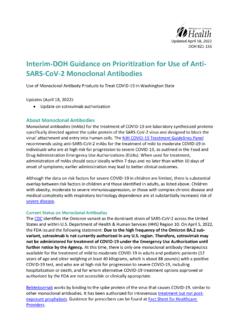Transcription of Official American Thoracic Society/Centers for Disease ...
1 Clinical infectious DiseasesIDSA GUIDELINEO fficial American Thoracic Society/Centers for DiseaseControl and prevention / infectious Diseases society ofAmerica Clinical Practice guidelines : treatment ofDrug- susceptible TuberculosisPayam Nahid,1 Susan E. Dorman,2 Narges Alipanah,1 Pennan M. Barry,3 Jan L. Brozek,4 Adithya Cattamanchi,1 Lelia H. Chaisson,1 Richard E. Chaisson,2 Charles L. Daley,5 Malgosia Grzemska,6 Julie M. Higashi,7 Christine S. Ho,8 Philip C. Hopewell,1 Salmaan A. Keshavjee,9 Christian Lienhardt,6 Richard Menzies,10 Cynthia Merrifield,1 Masahiro Narita,12 Rick O Brien,13 Charles A.
2 Peloquin,14 Ann Raftery,1 Jussi Saukkonen,15H. Simon Schaaf,16 Giovanni Sotgiu,17 Jeffrey R. Starke,18 Giovanni Battista Migliori,11and Andrew Vernon81 University of California, San Francisco;2 Johns Hopkins University, Baltimore, Maryland;3 California Department of Public Health, Richmond;4 McMaster University, Hamilton, Ontario, Canada;5 National Jewish Health, Denver, Colorado;6 World Health Organization, Geneva, Switzerland;7 tuberculosis control Section, San Francisco Department of Public Health, California.
3 8 Division ofTuberculosis Elimination, National center for HIV/AIDS, Viral Hepatitis, STD, and TB prevention , Centers for Disease control and prevention , Atlanta, Georgia;9 Harvard Medical School, Boston,Massachusetts;10 McGill University, Montreal, Quebec, Canada;11 WHO Collaborating Centre for TB and Lung Diseases, Fondazione S. Maugeri Care and Research Institute, Tradate, Italy;12 tuberculosis control Program, Seattle and King County Public Health, and University of Washington, Seattle;13 Ethics Advisory Group, International Union Against TB and Lung Disease , Paris, France;14 University of Florida, Gainesville;15 Boston University, Massachusetts;16 Department of Paediatrics and Child Health, Stellenbosch University, Cape Town, South Africa;17 University of Sassari, Italy.
4 And18 Baylor College of Medicine, Houston, TexasThe American Thoracic society , Centers for Disease control and prevention , and infectious Diseases society of america jointlysponsored the development of this guideline for the treatment of drug - susceptible tuberculosis , which is also endorsed by the Eu-ropean Respiratory society and the US National tuberculosis Controllers Association. Representatives from the American Academyof Pediatrics, the Canadian Thoracic society , the International Union Against tuberculosis and Lung Disease , and the World HealthOrganization also participated in the development of the guideline.
5 This guideline provides recommendations on the clinical andpublic health management of tuberculosis in children and adults in settings in which mycobacterial cultures, molecular and phe-notypic drug susceptibility tests, and radiographic studies, among other diagnostic tools, are available on a routine basis. For allrecommendations, literature reviews were performed, followed by discussion by an expert committee according to the Grading ofRecommendations, Assessment, Development and Evaluation methodology.
6 Given the public health implications of prompt diag-nosis and effective management of tuberculosis , empiric multidrug treatment is initiated in almost all situations in which activetuberculosis is suspected. Additional characteristics such as presence of comorbidities, severity of Disease , and response to treatmentinfluence management decisions. Specific recommendations on the use of case management strategies (including directly observedtherapy), regimen and dosing selection in adults and children (daily vs intermittent), treatment of tuberculosis in the presence ofHIV infection (duration of tuberculosis treatment and timing of initiation of antiretroviral therapy), as well as treatment of extrap-ulmonary Disease (central nervous system, pericardial among other sites) are provided.
7 The development of more potent and better-tolerated drug regimens, optimization of drug exposure for the component drugs, optimal management of tuberculosis in specialpopulations, identification of accurate biomarkers of treatment effect, and the assessment of new strategies for implementing regi-mens in thefield remain key priority areas for research. See the full-text online version of the document for detailed discussion of themanagement of tuberculosis and recommendations for tuberculosis ; HIV infections; antitubercular agents; case management.
8 Public SUMMARYThe American Thoracic society (ATS), Centers for Disease Con-trol and prevention (CDC), and infectious Diseases society ofAmerica (IDSA) jointly sponsored the development of thisguideline on the treatment of drug - susceptible tuberculosis ,which is also endorsed by the European Respiratory society (ERS) and the US National tuberculosis Controllers Association(NTCA). This guideline provides recommendations on the clin-ical and public health management of tuberculosis in childrenand adults in settings in which mycobacterial cultures, molecularReceived 4 June 2016; accepted 6 June guidelines were endorsed by the European Respiratory society (ERS) and the US Na-tional tuberculosis Controllers Association (NTCA).
9 It is important to realize that guidelines can-not always account for individual variation among patients. They are not intended to supplantphysician judgment with respect to particular patients or special clinical situations. The spon-soring and endorsing societies consider adherence to these guidelines to be voluntary, with theultimate determination regarding their application to be made by the physician in the light ofeach patient s individual : P. Nahid, University of California, San Francisco, San Francisco General Hos-pital, Pulmonary and Critical Care Medicine, 1001 Potrero Ave, 5K1, San Francisco, CA infectious Diseases The Author 2016.
10 Published by Oxford University Press for the infectious Diseases Societyof america . All rights reserved. For permissions, e-mail Clinical Practice guidelines for drug - susceptible TB CID 1 Clinical infectious Diseases Advance Access published August 10, 2016 at IDSA member on August 11, 2016 from and phenotypic drug susceptibility tests, and radiographic stud-ies, among other diagnostic tools, are available on a routine PICO (population, intervention, comparators, outcomes)questions and associated recommendations, developed basedon the evidence that was appraised using GRADE (Grading ofRecommendations Assessment, Development, and Evaluation)methodology [1, 2], are summarized below.












